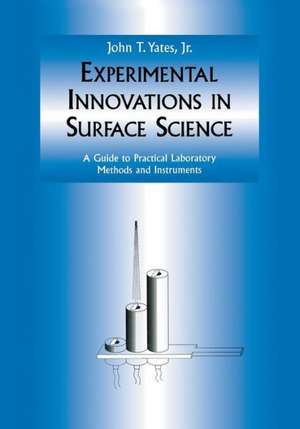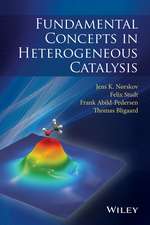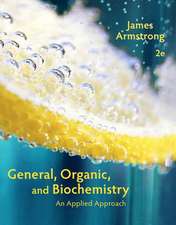Experimental Innovations in Surface Science: A Guide to Practical Laboratory Methods and Instruments
Autor John T., Jr. Yatesen Limba Engleză Paperback – 2 oct 2011
Preț: 984.59 lei
Preț vechi: 1200.72 lei
-18% Nou
Puncte Express: 1477
Preț estimativ în valută:
188.41€ • 201.47$ • 157.09£
188.41€ • 201.47$ • 157.09£
Carte tipărită la comandă
Livrare economică 18 aprilie-02 mai
Preluare comenzi: 021 569.72.76
Specificații
ISBN-13: 9781461274933
ISBN-10: 1461274931
Pagini: 924
Ilustrații: XV, 904 p.
Dimensiuni: 178 x 254 x 49 mm
Greutate: 1.57 kg
Ediția:Softcover reprint of the original 1st ed. 1998
Editura: Springer
Colecția Springer
Locul publicării:New York, NY, United States
ISBN-10: 1461274931
Pagini: 924
Ilustrații: XV, 904 p.
Dimensiuni: 178 x 254 x 49 mm
Greutate: 1.57 kg
Ediția:Softcover reprint of the original 1st ed. 1998
Editura: Springer
Colecția Springer
Locul publicării:New York, NY, United States
Public țintă
Professional/practitionerDescriere
he modern era of surface science, developed in the last 30 years, features hundreds of T new physical and chemical measurement methods such as low-energy electron diffraction and Auger electron spectroscopy, which form a vital foundation for the field. These measurement methods constitute the basis for a number of books used by begin ning students as their introduction to experimental research. This book is not about this particular experimental core of the field. Instead, it is about those practical laboratory methods used throughout the field, but seldom communicated coherently in writing and drawings to beginning students. These practical methods of design, construction, and measurement also form their own foundation for making pos sible significant research. They constitute a gold mine of clever ideas and "tricks of the trade" about how to use basic materials and components effectively for research and mea surement in surface science. Approximately 250 practical methods are described in the book in enough detail that one could design a new experimental device from the book alone. This book will be useful to beginning research workers in surface science as well as to those who work with similar methods in fields such as semiconductor technology, mate rials science, and physical electronics.
Cuprins
I. Vacuum System Technology.- A. Motion in Vacuum.- 1. Crystal Manipulator with Six Degrees of Motional Freedom.- 2. Rotation in Ultrahigh Vacuum.- 3. Crystal Positioning Using Capacitance.- 4. UHV Rotary Manipulator with Arcsec Resolution.- 5. Solenoid Driven Linear Motion Device.- 6. An Inexpensive Linear Motion Device.- 7. Translating Auger Spectrometer.- 8. Simple Multiple Motion Manipulator.- 9. Simple Device for Small Rotations in Ultrahigh Vacuum—Grating Application.- 10. Turntable Rotation in Ultrahigh Vacuum.- 11. Small Motions in UHV Systems Using Shape Memory Effect Alloys.- 12. Rotary Shutter Device Driven by Magnetic Eddy Current.- 13. High-Speed Ultrahigh Vacuum Motor.- 14. High-Speed Rotary Feedthrough for UHV Operation.- 15. Self-Lubricating Bearings in UHV.- 16. Lubrication for Heavy Sliding Loads in Ultrahigh Vacuum.- 17. Simple UHV Bearings for High-Speed Shafts.- 18. Flange-Mounted UHV Variable Aperture.- 19. Linear Motion Platform (LMP).- 20. Thermally Compensated STM with Repeatable Sample Positioning.- B. Sample Transfer.- 21. Sample Transfer from High Pressure to Ultrahigh Vacuum.- 22. Novel Sample Transfer from UHV Chamber to External Cell.- 23. UHV Sample Transfer Device with Low-Temperature Capability.- 24. Internal Cup High-Pressure Cell.- 25. High-Pressure Transfer Cell.- 26. Sample Transfer with Disconnect-I.- 27. Sample Transfer with Disconnect-II.- 28. UHV Access Port.- C. Electrical Connections.- 29. Tungsten Ribbon—Attachment to Power Leads.- 30. Wrap Connection—Tungsten to Tungsten.- 31. Cold-Formed Wire Connector.- 32. Ultrahigh Resistance Vacuum Feedthroughs.- 33. Sliding Metal Electrical Contact.- 34. Low-Profile Electrical Lead Clamp.- D. Pumping and Trapping.- 35. Water Aspirator/Sorption Pump Combination for Efficient UHV System Evacuation.- 36. Ballast Pumping—Vibration Free.- 37. The Use of Appendage Titanium Sublimation Pumps for Pumping Low Gas Loads in Ultrahigh Vacuum.- 38. Pressure-Equalizing Device in Complex Systems.- 39. Diode Ion Pump Performance in He Pumping.- 40. Vacuum Applications of Metal Foams.- 41. Cleaning of Ion Pumps by Chemical Etching.- 42. An Efficient Liquid Nitrogen Trap.- E. Bakeout.- 43. Bakeout of Metal Ultrahigh Vacuum Systems.- F. Behavior of UHV Systems.- 44. Wall Passivation in Stainless Steel Ultrahigh Vacuum Systems.- 45. Minimizing Wall Reactions in Ultrahigh Vacuum Systems—Gas Dosers.- G. Mechanical Action on Samples.- 46. Simple UHV Crystal Cleaver.- 47. Piezoelectric Fatigue Apparatus for UHV Operation.- H. Gasket Seals.- 48. Gasket Seals for Ultrahigh Vacuum Systems.- 49. Cryogenic Gasket Seals.- 50. Copper Gasket Removal Devices.- 51. Unconventional Compression Seals for Ultrahigh Vacuum.- I. Leak Repairs and Detection.- 52. Coaxial Pumped He Leak Detection Probe.- 53. Temporary Leak Sealing of Welded Bellows.- 54. Atmospheric Permeation—Viton O-Ring.- J. Specialized UHV Systems.- 55. Aluminum Ultrahigh Vacuum System.- 56. Surface Electrochemistry Apparatus.- II Mechanical Fabrication Techniques.- A. Grids.- 57. Hemispherical Grids—Formation and Piercing.- 58. Making Flat Mesh Grids of Large Size.- 59. Grid Fabrication Techniques—Conical Grid.- B. Conductive Coatings.- 60. Deposition of Electrically Conductive SnO2 Films.- C. Phosphor Screens.- 61. Sedimentation Method for Depositing Phosphor Screens.- 62. Dusting Method for Coating Phosphor Screens.- D. Thermionic Emitters.- 63. Thoriated Thermionic Emitters.- 64. Lanthanum Hexaboride Thermionic Emitters—Deposition on Metals.- 65. Directly Heated Lathanum Hexaboride Thermionic Emitters.- 66. Thermionic Emitter Mounting.- 67. Indirectly Heated Cathodes for High-Temperature Operation.- 68. Replacing Filaments in Glass Bayard-Alpert Gauges.- E. Shielding.- 69. Magnetic Shielding in Ultrahigh Vacuum.- 70. Electrical Isolation of UHV Components.- F. Single Crystal Fabrication/Orientation.- 71. Single Crystal Orientation, Grinding, and Polishing.- 72. A Simple Goniometer for Cutting Single Crystals.- 73. Ion Beam Polishing of Crystals to Subnanometer Roughness.- 74. Crystal Optical Alignment.- 75. Measurement of the Angles of Incidence in a LEED Experiment.- 76. Measurement of Angle of Incidence of an Electron Beam on a Single Crystal.- G. Tip Fabrication.- 77. Fabrication of Metal Tips Using Zone Electropolishing.- 78. Etching STM Tips Reproducibly.- 79. Sharpening Single Crystal Metal Tips by Ion Bombardment.- H. Spot-Welding.- 80. Spot-Welding Difficult Junctions.- I. Mechanical Procedures.- 81. Stretching Thin Metal Foils to a Wrinkle-Free Condition.- 82. Making Micron-Size Holes for Supersonic Nozzles.- 83. Straightening and Braiding Wires.- III. Measurement Methods.- A. Electrons.- 84. Electron Gun Design and Behavior.- 85. Low-Energy Electron Gun for Broad Beam Irradiation.- 86. Low-Energy Electron Gun for Broad Beam Irradiation—Cylindrical Symmetry.- 87. Electron Energy Analyzers.- 88. Electron Spectrometer Calibration Using Graphite.- 89. Measurement of Electron Beam Angular Divergence.- 90. Spot Photometer for LEED Intensity Measurements.- 91. Modified Faraday Cup for Electron Current Measurement.- 92. Rejuvenation of Cu/Be Electron Multipliers.- 93. Geiger-Müller Counter for Inverse Photoemission.- B. Ions.- 94. Ion Sputter Gun with Low Gas Emission.- 95. Alternate Ion Bombardment Sources.- 96. Ion Gun Based on Bayard-Alpert Gauge.- 97. Sputter Ion Gun—Cold Cathode.- 98. Broad Ion Sources—Improved Stability with Oxygen.- 99. Focusing of Low—Energy Ions by Magnetic Field.- 100. Measuring Ion Beam Dimensions.- 101. Beam Position Monitor—Charged Particles.- 102. Pulse-Counting LEED/ESDIAD Analyzer—Using MicroChannel Plate Detection.- 103. Time-of-Flight Detection for Laser-Ionized Neutrals.- C. Photons (UV).- 104. Hollow Cathode Resonance Lamp for He(II) (40.8eV) Photoemission.- 105. He(I) and He(II) Ultraviolet Resonance Source.- 106. Photochemistry on Surfaces Using an Ultraviolet Lamp.- 107. Use of Polarized Ultraviolet Light for Photochemistry.- D. Kinetics of Adsorption/Adsorbate Coverages.- 108. Absolute Adsorption Uptake Measurements from a Calibrated Effusive Molecular Beam.- 109. Measurement of Absolute Sticking Coefficient at Desorption Temperature.- E. Mass Spectrometry.- 110. Shielded Quadrupole Mass Spectrometers—Temperature-Programmed Desorption.- 111. Enhanced Signal-to-Noise in Quadrupole Mass Spectrometers.- 112. Elimination of Spurious Electron Emission from a Quadrupole Mass Spectrometer.- 113. Ta Mass Spectrometer Filament.- 114. Mass Spectrometer Calibration by Molecular Decomposition.- F. Temperature-Programmed Desorption/Reaction.- 115. Thermal Desorption—Angular Resolved.- 116. Magic-Angle Thermal Desorption Mass Spectroscopy.- 117. High-Temperature Thermal Desorption Spectroscopy.- 118. Scanning Kinetic Spectroscopy—A Survey Method for Investigation of Surface Reaction Processes.- 119. Temperature-Programmed Reaction Spectroscopy.- G. Gas Chromatography—Enhanced Sensitivity.- 120. Gas Chromatography—Sensitivity Enhancement.- H. Work Function.- 121. Work Function Changes Using Retarding Diode Method.- 122. Work Function Measurements Using an Electron Gun.- 123. Work Function and Electron Reflection Coefficient Measurements with the Shelton Diode.- 124. Improved Piezoelectric Drive Kelvin Probe.- 125. Improved Electromagnet Drive Kelvin Probe.- 126. Kelvin Probe—High Temperature Flow Reactor.- I. Radioactive Adsorbates.- 127. Radiotracer Techniques for Surface Studies.- J. Thin Film Deposition.- 128. Thin Film Deposition to Absolute Surface Coverages.- 129. Ionization Gauge Measurement of Film Evaporation Rate.- 130. Reusable Quartz Crystals for Film Thickness Measurement.- 131. Hybrid Thin Film Deposition Processes—Stable and Metastable Films.- 132. Sputter-Coating Inner Walls of Tubes.- K. Infrared Spectroscopy.- 133. Infrared Reflection Absorption Spectrometer.- 134. IRAS Measurements at High Pressure.- 135. Internal Reflection IR Spectroscopy—Silicon.- 136. Internal Reflection IR Spectroscopy—Gallium Arsenide.- 137. Infrared Spectroscopy—Continuous Pumping of Detector Dewar.- L. Calorimeteric Heats of Adsorption—Single Crystals.- 138. Measurement of the Calorimetrie Heat of Adsorption on Ultrathin Metal Single Crystals.- M. Surface Debye Temperature.- 139. Measuring the Surface Debye Temperature of a Single Crystal.- N. Friction.- 140. UHV Tribometer for Measuring the Coefficient of Friction.- 141. Pin-on-Disk Measurement—UHV.- IV. Thermal Control.- A. Heating Samples.- 142. Electronic Temperature Programmer—Metal Crystals.- 143. Temperature Programming of Metal and Semiconductor Crystals.- 144. Mounting Nonweldable Crystals for Resistive Heating and Cooling.- 145. Strain Free Single Crystal Mounting—Azimuthal Motion.- 146. Heating Silicon Crystals and Temperature Measurements.- 147. Avoiding Extraneous Electrical Effects Owing to Heating Crystals.- 148. Electron Bombardment Crystal Heating.- 149. Indirect Sample Heating.- 150. Indirect Heating of Compound Semiconductors.- 151. Heating Design—Insulator Crystals.- 152. Cement Mounting—Semiconductor Crystals.- 153. Low-Stress Mount for Fragile Semiconductor Crystals.- 154. Radiation Heating of Crystals through Glass Windows.- 155. Pyrolytic Graphite Heating Element for UHV.- 156. Heater—Paint-on Type.- 157. Mounting High-Temperature Tungsten Filaments.- B. Cooling Samples.- 158. 6 K—Cryogenic Crystal Holder.- 159. Cooling Crystals by Contact with a Thermal Reservoir.- 160. Cooling Samples on Manipulators—Thermal Conductivity Issues.- 161. Vacuum-Jacketed Cryogenic Manipulator Rod.- 162. Manipulator Component with Cryogenic Azimuthal Rotation.- 163. Cooling Using Direct Contact.- 164. Cooling Reservoir—Horizontal Manipulator.- 165. Cryogenic Connections.- 166. Sample Cooling Using Thermal Braid.- 167. Flexible Cooling Reservoir.- 168. Enhanced Cooling Using Liquid Nitrogen.- 169. Level Alarm—Liquid Nitrogen.- 170. Gas Thermal Switch.- C. Temperature Measurements.- 171. Tungsten-Rhenium Thermocouples—Calibration Over a Wide Temperature Range.- 172. Measuring Temperatures of Hot Filaments.- 173. Pyrometric Measurement of Temperatures.- 174. Pyrometer Measurements Through Windows Coated Inadvertently with Variable-Thickness Thin Films.- 175. Calibration Point for Optical Pyrometer Used for Silicon.- 176. Control of Silicon Temperature Using Resistivity.- V. Delivery of Adsorbates to Surfaces.- A. Gases.- 177. Design and Performance of Microcapillary Array Beam Doser.- 178. Gas Handling System for Array Beam Doser.- 179. Calibration and Use of Array Beam Doser.- 180. Beam Doser Shutoff—Condensable Gases.- 181. Neutral Beam Intensity Measurement Using a Stagnation Detector.- 182. Low Deadspace Aperture Valve for Repetitive Gas Dosing.- 183. Gas Flow Regulation—Squeeze Valve.- B. Evaporation Sources.- 184. Degassing Evaporation Sources.- 185. Metal Evaporation Sources for Downward Evaporation.- 186. Ultralow Coverage Metal Evaporation.- 187. Congruent Evaporation of Multicomponent Materials.- 188. Evaporator for Eutectic-Forming Metals.- 189. Simple Lithium Metal Evaporation Source.- 190. Aluminum Evaporation Sources—Long Lived.- 191. Cr Evaporator Sources of Compact Design.- 192. Electron Beam Evaporator for Refractory Materials.- 193. Small Electron Beam Evaporator for Refractory Metals.- 194. Electron Beam Evaporator.- 195. Break-Seal Ampoule Doser.- 196. Cadmium Sulfide Evaporation Source.- 197. Arsenic Atom Source.- 198. Vapor Deposition of Organic Thin Films.- C. Ions.- 199. Solid State Cesium Ion Gun Source.- 200. Alkaline Earth Metal Ion Sources.- D. Active Gases and Species.- 201. High Flux Atomic Hydrogen Sources—Thermal.- 202. Atomic Hydrogen Beam Source—Radio Frequency Driven.- 203. Atomic Fluorine Source.- 204. Alkali Metal Sources.- 205. Thermal Source of Methyl Free Radicals.- 206. Production, Storage, and Use of Ozone.- 207. Detection of Ozone or Atomic Oxygen by Oxidation of Silver Films.- E. Electrochemical Sources.- 208. Electrochemical Sulfur Source.- 209. Electrochemical Halogen Sources.- F. Gas Purification.- 210. Gas Purification for Experiments at High Pressures.- 211. Production and Purity Measurement for Extremely Pure He.- 212. Purification of Gases by Cryogenic or Gettering Methods.- 213. Gas Purification by Permeation Through Metals.- 214. O2 Source—Solid State.- 215. Reusable Sample Holder for Hydrogen Permeation Studies.- VI. UHV Windows.- A. Spectroscopic Windows.- 216. Mounting Infrared Windows on UHV Systems.- 217. Windows for Vacuum UV Transmission into Ultrahigh Vacuum Systems.- 218. Construction of Be Windows for Ultrahigh Vacuum Use.- 219. Bakeable Aluminum Ultrahigh Vacuum Window.- 220. Metal Thin Foil Windows—Welding.- 221. Preparation of Large-Area Si Single Crystal Windows.- 222. Strain-Free Optical Window Mounting.- B. Observation Windows.- 223. Shielded Observation Window.- 224. Heated Internal Window for Prevention of Film Deposition.- 225. UHV Glass Window Seal—Low Optical Distortion.- 226. Zero Length Window Assembly.- VII. Surface Preparation Methods.- A. Cleaning Metal and Semiconductor Crystals—Examples.- 227. Surface Segregation and the Cleaning of Metal Single Crystals.- 228. Chemical Method to Measure and Remove Carbon from Pd.- 229. Surface Cleaning Procedures—Silicon.- VIII. High-Area Solids.- A. Infrared Cells.- 230. Infrared Cell for Adsorption Studies on Supported Catalysts.- 231. Wide-Temperature-Range IR Cell for High-Area Solids.- B. Adsorption/Desorption—Thermal.- 232. Adsorption and Desorption from High-Area Solids.- 233. Microcalorimetric Studies of Adsorption Heat on Powders.- IX. Safety.- A. Protecting the Vacuum System.- 234. Delay Circuit for Turbopumping Protection Against Vacuum Loss from Power Interruptions.- 235. Fast-Closing Beam Valve for UHV Chamber Protection.- 236. Safety System for Oil Diffusion-Pumped UHV Systems.- 237. Folding Linear Magnetic Translator.- B. Protecting Personnel.- 238. Electrical Shocks in the Laboratory.- 239. Accidental Electrical Charging from Ionization Gauge.- Appendixes.- Appendix A. Useful Books—Experimental Surface Science Methods.- Appendix B. Manufacturers.- I. United States, United Kingdom, and Canada.- II. Germany and Europe.- III. Japan.
Caracteristici
A definitive volume invaluable to surface scientists containing over 900 pages of richly illustrated descriptions of methods, instruments, and tools The methods are arranged in topical groupings for easy reference and described succinctly, with a clear sketch of the apparatus involved (and, in many cases, of the physical principles as well)
Covers all the basic methods of surface science Serves not only as a useful reference to those beginning experimental research, but also as a manual for seasoned researchers
Covers all the basic methods of surface science Serves not only as a useful reference to those beginning experimental research, but also as a manual for seasoned researchers





